
Base Year Value ()
CAGR ()
Forecast Year Value ()
Historical Data Period
Largest Region
Forecast Period
놀이기구별(기계식 놀이기구, 워터 라이드) 유형별(테마파크, 워터파크, 어드벤처 파크, 동물원 파크) 용도별(어린이, 성인 및 기타) 및 지역별 놀이공원 시장, 2024년부터 2030년까지의 글로벌 트렌드 및 예측
Instant access to hundreds of data points and trends
- Market estimates from 2014-2029
- Competitive analysis, industry segmentation, financial benchmarks
- Incorporates SWOT, Porter's Five Forces and risk management frameworks
- PDF report or online database with Word, Excel and PowerPoint export options
- 100% money back guarantee
놀이공원 시장 개요
글로벌 놀이공원 시장 규모는 2023년 598억 1,000만 달러에서 2030년 911억 3,000만 달러로 성장할 것으로 예상되며, 예측 기간 동안 연평균 성장률은 6.2%를 보일 것으로 예상됩니다.
놀이공원은 다양한 놀이기구, 어트랙션, 액티비티를 통해 오락과 즐거움을 제공하는 레크리에이션 장소입니다. 이러한 공원은 특히 손님에게 다양한 스릴 넘치고 즐거운 경험을 제공하도록 설계되었습니다. 롤러코스터, 관람차, 워터 라이드, 회전목마 및 기타 테마 어트랙션은 놀이공원에서 흔히 볼 수 있습니다. 전체적인 경험을 향상시키기 위해 공원은 종종 화려한 장식, 활기찬 음악 및 축제 분위기가 있는 역동적인 환경을 통합합니다. 놀이공원은 가족 친화적인 놀이기구와 더욱 스릴 넘치는 어트랙션이 결합되어 모든 연령대의 사람들을 대상으로 합니다. 일상에서 벗어나고자 하는 사람들에게 인기 있는 장소로, 어울리고, 휴식을 취하고, 기억에 남는 추억을 만들 수 있는 공간을 제공합니다. 놀이공원의 성공은 혁신, 엔터테인먼트 및 모험심을 결합하여 방문객을 사로잡고 일상에서 벗어나 몰입적이고 즐거운 탈출구를 제공하는 능력에 있습니다.
[캡션 id="attachment_36766" 정렬="정렬센터" 너비="1033"]
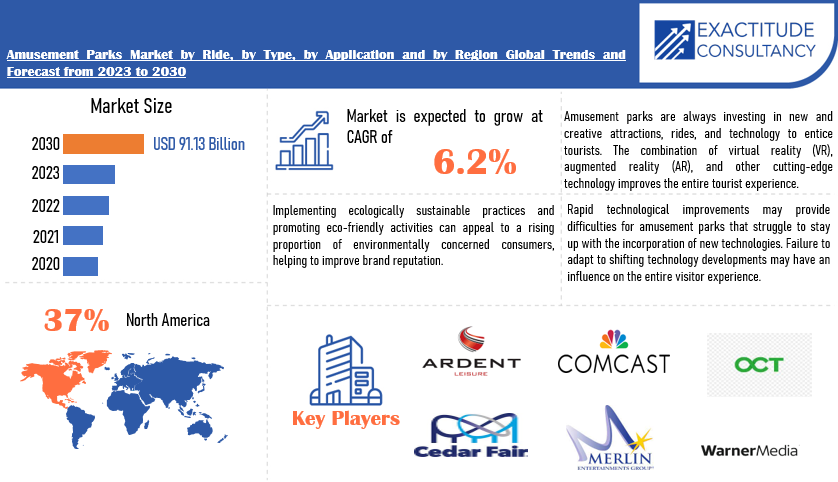
Amusement parks play an important role in modern life as entertainment and relaxation hubs. These parks are culturally and socially significant because they provide a unique and accessible environment for individuals to relax, interact with family and friends, and escape the stresses of daily life. They help the tourist sector by bringing people from near and far, which boosts local economies. Amusement parks also help to foster creativity and innovation by developing cutting-edge rides and attractions. Furthermore, they provide work possibilities by hiring a wide spectrum of specialists, from ride operators to performers. Amusement parks, being places of joy and celebration, contribute to people's general well-being by instilling feelings of enjoyment, excitement, and wonder. These parks also frequently hold events, festivals, and educational activities, which contribute to the cultural fabric of the communities they serve. In essence, amusement parks are economically and culturally significant, having a complex influence on the lives of individuals who frequent them. As spaces of joy and celebration, amusement parks contribute to the overall well-being of individuals by fostering happiness, excitement, and a sense of wonder. Additionally, these parks often host events, celebrations, and educational programs, further enriching the cultural fabric of the communities they inhabit. In essence, amusement parks hold both economic and cultural significance, offering a multifaceted impact on the lives of those who visit them.
| ATTRIBUTE | DETAILS |
| Study period | 2020-2030 |
| Base year | 2022 |
| Estimated year | 2023 |
| Forecasted year | 2023-2030 |
| Historical period | 2019-2021 |
| Unit | Value (USD Billion) |
| Segmentation | By Ride, Type and Region |
| By Ride |
|
| By Type |
|
By Application |
|
| By Region |
|
Frequently Asked Questions
• What is the market size for the Amusement Parks Market?
The global amusement parks market size is projected to grow from USD 59.81 billion in 2023 to USD 91.13 billion by 2030, exhibiting a CAGR of 6.2% during the forecast period.
• Which region is dominating in the Amusement Parks Market?
North America accounted for the largest market in the amusement parks market.
• Who are the major key players in the Amusement Parks Market?
Ardent Leisure Group, Cedar Fair Entertainment Company, Chimelong Group Co. Ltd, Comcast Corporation, Fantawild Holdings Inc., Fuji-Q Highland, Hershey Entertainment and Resorts Company, Hong Kong Disneyland,IMG Worlds of Adventure, Merlin Entertainments, OCT Limited, Oriental Land Company, Parques Reunidos, SeaWorld Parks & Entertainment Inc., Shanghai Disneyland, Six Flags Entertainment Corporation, The Walt Disney Company, Tokyo Disneyland, Universal Studios Theme parks, Warner Media LLC.
• What are the key trends in the Amusement Parks Market?
Amusement park operators are looking for ways to expand globally. This involves establishing parks in emerging markets and collaborating with multinational businesses to develop new attractions.
Amusement Parks Market Segmentation Analysis
The global amusement parks market is bifurcated three segments, by type, ride and region. By ride, the market is bifurcated mechanical rides, water rides. By type, the market is bifurcated into theme parks, water parks, adventure parks, zoo parks and region.
[caption id="attachment_36774" align="aligncenter" width="737"]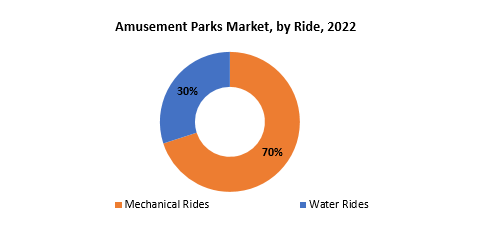
In the field of amusement and entertainment, the market for rides may be generally divided into two categories: mechanical and aquatic rides. Mechanical rides include a wide range of attractions that use machinery, engineering, and technology to deliver exciting and dynamic experiences. These rides frequently feature roller coasters, Ferris wheels, carousels, and other gravity-defying structures meant to provoke thrill and adrenaline in passengers. The mechanical rides industry is continually evolving, adding cutting-edge technologies to improve the whole experience and fulfill the increasing need for innovation. On the other hand, water rides comprise a different segment within the amusement sector, emphasizing aquatic features to give refreshing and thrilling experiences. Water rides may range from calm, family-friendly attractions like lazy rivers and water slides to more thrilling options like water coasters and wave pools. The concentration on water not only adds excitement but also gives relief from the heat, making these rides especially popular in hotter countries. Water parks, in particular, use the popularity of water rides to provide tourists with a full and fun aquatic experience. Mechanical and water rides both add to the amusement market's diversity and attractiveness, appealing to a wide range of interests and demographics. As technology advances, we should expect further developments in both categories, ensuring that the ride market remains a vibrant and vital part of the worldwide entertainment sector.
[caption id="attachment_36776" align="aligncenter" width="721"]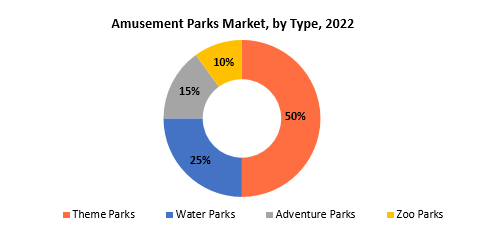
The amusement ride market is divided into two categories: mechanical rides and water rides. Mechanical rides, distinguished by their precise engineering and technology, provide a wide range of attractions that provide thrilling experiences to guests. These can include classic roller coasters, Ferris wheels, and other gravity-defying constructions meant to provide thrills and excitement. This category is continually evolving with technology developments, providing improvements to improve the entire riding experience and keep the industry competitive. Water rides, on the other hand, are a distinct segment of the amusement industry that focuses heavily on aquatic aspects to give refreshing and thrilling enjoyment. Water rides, which range from family-friendly alternatives like lazy rivers and water slides to more extreme experiences like water coasters and wave pools, provide a unique combination of thrill and cooling relief, making them especially desirable in hotter weather. Water parks take use of these attractions' popularity to develop full aquatic experiences that appeal to a wide range of visitors. Mechanical and water rides both contribute greatly to the amusement market's depth and diversity by catering to various populations' interests. With continuous technology improvements, these ride categories are expected to see further innovations, ensuring the vitality and attractiveness of amusement parks and entertainment venues throughout the world.
[caption id="attachment_36777" align="aligncenter" width="755"]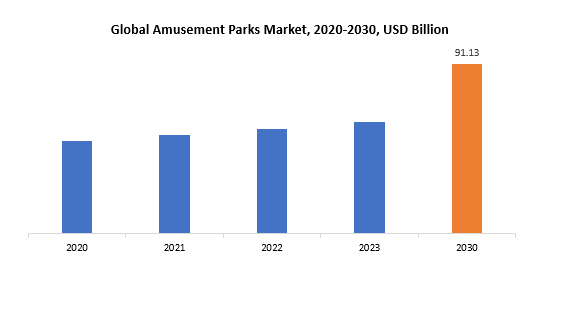
Amusement Parks Market Dynamics
DriverThe rise in disposable income among consumers has emerged as a pivotal factor propelling the growth of the amusement parks market.
The increase in consumer disposable income has emerged as a key driver driving the expansion of the amusement park sector. As people's disposable income rises, a larger share of their wages become accessible for discretionary expenditure, notably on leisure and recreation. This economic empowerment leads to a greater desire and capacity to devote monies for leisure activities, with amusement parks standing out as particularly appealing destinations for such expenditures. Consumers with greater disposable income are more likely to seek out fresh and entertaining experiences, and amusement parks provide a wide range of attractions, rides, and entertainment alternatives. These locations, frequently distinguished by their immersive and exhilarating offers, become enticing alternatives for people and families wishing to enjoy in activities that go beyond routine daily experiences. Whether it is the allure of cutting-edge rides, themed attractions, or immersive entertainment, the discretionary spending capacity afforded by rising incomes becomes a driving force in drawing people to amusement parks. Furthermore, the leisure and entertainment business relies on the idea of offering unique and delightful experiences, and as disposable incomes rise, so do expectations for the quality of these experiences. Amusement parks meet this need by constantly innovating, introducing new attractions, and using innovative technologies to improve the entire tourist experience. This ongoing evolution guarantees that these parks remain appealing places for visitors looking for entertainment and leisure activities.
RestraintThe amusement parks industry is characterized by significant initial investments and ongoing operational costs, presenting a formidable challenge to operators.
Amusement park building and maintenance need significant financial resources, with major charges including site purchase, ride installation, infrastructure development, and day-to-day operations costs. These large upfront and recurring expenditures can have a significant influence on amusement park profitability, particularly during economic downturns. The upfront investment is considerable and diverse. Land purchase, especially in prominent tourist destinations, accounts for a significant amount of the initial cost. Furthermore, the construction of rides and the production of themed attractions necessitate major financial investment. Infrastructure development, such as the building of facilities, parking lots, and landscaping, increases the initial cost load. These significant initial investments need thorough financial planning and risk assessment by operators since they provide the groundwork for the park's profitability and sustainability. Ongoing operational expenditures exacerbate the financial difficulties. Employee pay, ride and facility maintenance, utilities, marketing initiatives, and compliance with safety and regulatory requirements all add to daily expenditures. Furthermore, amusement parks frequently require ongoing innovation to remain competitive and fulfill changing consumer expectations. This dynamic environment necessitates constant capital expenditures to offer new attractions and technology, guaranteeing the park's relevance and appeal to visitors.
OpportunitiesExploring and expanding into untapped or emerging markets provides an opportunity for growth.
Expansion into emerging economies is a strategic growth opportunity for the amusement park sector, with the ability to reach new customer bases and capitalize on rising demand for leisure and entertainment activities. This proactive strategy entails either developing wholly new parks or forming strategic alliances with local entities in areas with rising disposable incomes and a growing middle class. Establishing new parks in growing areas allows amusement park owners to present their brand and services to a previously untapped market. Regions experiencing economic progress and a rising middle class frequently see an increase in demand for leisure and entertainment activities. Strategic agreements with local institutions, such as governments, real estate developers, or entertainment firms, provide an alternate road to growth. Collaboration with established regional players may give valuable insights into local preferences, regulatory contexts, and cultural subtleties. Such collaborations help speed up the entrance process by using the local partner's experience and resources for a more seamless market penetration.
Amusement Parks Market Trends
-
Amusement parks are continuing to incorporate cutting-edge technology to improve guest experiences. Rides and attractions are increasingly using augmented reality (AR), virtual reality (VR), and interactive technology to provide a more immersive and engaging atmosphere.
-
There is a rising emphasis on developing immersive and themed experiences at amusement parks. To attract a larger audience, parks are increasingly investing on themed attractions based on popular movie, television, and video game brands.
-
With rising environmental consciousness, some amusement parks are implementing sustainable methods. This comprises energy-saving technology, waste-reduction strategies, and environmentally responsible design ideas.
-
Amusement parks are using data analytics to provide visitors with more tailored experiences. This includes tailored suggestions, customized transportation experiences, and targeted marketing campaigns.
-
There is a tendency of giving additional attractions and entertainment alternatives for the entire family. This contributes to recruiting a larger audience and ensuring that there are activities for visitors of all ages.
-
Amusement parks are increasingly focusing on delivering a varied and high-quality food and beverage selection. Some parks are introducing themed eating experiences to go with their overall concept.
-
Many amusement parks are implementing digital ticketing systems and smartphone applications to improve the overall tourist experience. These solutions not only make ticket sales easier, but they also include features like as real-time ride wait times and interactive park maps.
Competitive Landscape
The competitive landscape of the amusement parks market was dynamic, with several prominent companies competing to provide innovative and advanced amusement parks.
- Ardent Leisure Group
- Cedar Fair Entertainment Company
- Chimelong Group Co. Ltd
- Comcast Corporation
- Fantawild Holdings Inc.
- Fuji-Q Highland
- Hershey Entertainment and Resorts Company
- Hong Kong Disneyland
- IMG Worlds of Adventure
- Merlin Entertainments
- OCT Limited
- Oriental Land Company
- Parques Reunidos
- SeaWorld Parks & Entertainment Inc.
- Shanghai Disneyland
- Six Flags Entertainment Corporation
- The Walt Disney Company
- Tokyo Disneyland
- Universal Studios Theme parks
- Warner Media LLC
November 16, 2023 — For fans of the Trolls franchise, Trolls Band Together releases only in theaters on November 17, but the true magic of Trolls doesn’t stop at the screen. It lives on in the imagination of kids as they play-out the happy world of the Trolls in their own way.
June 23, 2023 - Introducing ‘New TusenFryd’ Park’s new ride, ‘The Storm: The Dragon Legend’ TusenFryd is transforming itself from a traditional amusement park into a theme park with distinctly separate zones. One of the top projects of this investment is a single, impressive attraction; this is the high-speed, grueling roller coaster, ‘Storm: The Dragon Legend’, which opened to the public on April 29th, 2023, after an investment of approx. €9 million.
Regional Analysis
North America continues to be one of the world's leading amusement park markets. The United States, in particular, has a substantial number of well-known and famous theme parks, including those owned by industry titans such as The Walt Disney Company and Universal Parks & Resorts. Disneyland Resort in California, Walt Disney World Resort in Florida, and Universal Studios parks all attract millions of tourists each year. Furthermore, the amusement park sector in North America benefits from a varied choice of attractions that appeal to people of all ages and inclinations. The region's parks frequently incorporate cutting-edge technology, immersive experiences, and a steady infusion of new attractions, which add to the overall attractiveness for both local and foreign travelers.
[caption id="attachment_36780" align="aligncenter" width="667"]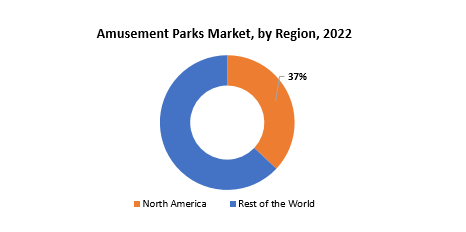
While North America has been the leading participant, other regions, particularly Asia, have seen tremendous growth in the amusement park industry. China, in particular, has witnessed significant investment and development in the theme park business, with the opening of new parks and the expansion of old ones. It is crucial to note that the dynamics of the amusement park business can change over time, with regional dominance shifting owing to variables such as economic development, population expansion, and strategic investments by industry participants. For the most up-to-date and reliable information, consult current market studies and industry analysis.
Target Audience for Amusement Parks Market
- Young Adults
- Tourists and Travelers
- Children and Teens
- Corporate and Group Events
- Thrill-Seekers
- Seasonal Events Enthusiasts
- Local Residents
- Special Interest Groups
- Families
Segments Covered in the Amusement Parks Market Report
Amusement Parks Market by Ride- Mechanical Rides
- Water Rides
- Theme Parks
- Water Parks
- Adventure Parks
- Zoo Parks
- Children
- Adult
- Others
- North America
- Europe
- Asia Pacific
- South America
Key Question Answered
- What is the expected growth rate of the Amusement Parks Market over the next 7 years?
- Who are the key market participants Amusement Parks, and what are their market share?
- What are the end-user industries driving market demand and what is their outlook?
- What are the opportunities for growth in emerging markets such as Asia-Pacific, the Middle East, and Africa?
- How is the economic environment affecting the Amusement Parks Market, including factors such as interest rates, inflation, and exchange rates?
- What is the expected impact of government policies and regulations on the Amusement Parks Market?
- What is the current and forecasted size and growth rate of the global Amusement Parks Market?
- What are the key drivers of growth in the Amusement Parks Market?
- Who are the major players in the market and what is their market share?
- What are the distribution channels and supply chain dynamics in the Amusement Parks Market?
- What are the technological advancements and innovations in the Amusement Parks Market and their impact on product development and growth?
- What are the regulatory considerations and their impact on the market?
- What are the challenges faced by players in the Amusement Parks Market and how are they addressing these challenges?
- What are the opportunities for growth and expansion in the Amusement Parks Market?
- What are the product offerings and specifications of leading players in the market?
- INTRODUCTION
- MARKET DEFINITION
- MARKET SEGMENTATION
- RESEARCH TIMELINES
- ASSUMPTIONS AND LIMITATIONS
- RESEARCH METHODOLOGY
- DATA MINING
- SECONDARY RESEARCH
- PRIMARY RESEARCH
- SUBJECT-MATTER EXPERTS’ ADVICE
- QUALITY CHECKS
- FINAL REVIEW
- DATA TRIANGULATION
- BOTTOM-UP APPROACH
- TOP-DOWN APPROACH
- RESEARCH FLOW
- DATA SOURCES
- DATA MINING
- EXECUTIVE SUMMARY
- MARKET OVERVIEW
- GLOBAL AMUSEMENT PARKS MARKET OUTLOOK
- MARKET DRIVERS
- MARKET RESTRAINTS
- MARKET OPPORTUNITIES
- IMPACT OF COVID-19 ON THE AMUSEMENT PARKS MARKET
- PORTER’S FIVE FORCES MODEL
- THREAT FROM NEW ENTRANTS
- THREAT FROM SUBSTITUTES
- BARGAINING POWER OF SUPPLIERS
- BARGAINING POWER OF CUSTOMERS
- DEGREE OF COMPETITION
- INDUSTRY VALUE CHAIN ANALYSIS
- GLOBAL AMUSEMENT PARKS MARKET OUTLOOK
- GLOBAL AMUSEMENT PARKS MARKET BY RIDE, 2020-2030, (USD BILLION)
- MECHANICAL RIDES
- WATER RIDES
- GLOBAL AMUSEMENT PARKS MARKET BY TYPE, 2020-2030, (USD BILLION)
- THEME PARKS
- WATER PARKS
- ADVENTURE PARKS
- ZOO PARKS
- GLOBAL AMUSEMENT PARKS MARKET BY APPLICATION, 2020-2030, (USD BILLION)
- CHILDREN
- ADULT
- OTHERS
- GLOBAL AMUSEMENT PARKS MARKET BY REGION, 2020-2030, (USD BILLION)
- NORTH AMERICA
- US
- CANADA
- MEXICO
- SOUTH AMERICA
- BRAZIL
- ARGENTINA
- COLOMBIA
- REST OF SOUTH AMERICA
- EUROPE
- GERMANY
- UK
- FRANCE
- ITALY
- SPAIN
- RUSSIA
- REST OF EUROPE
- ASIA PACIFIC
- INDIA
- CHINA
- JAPAN
- SOUTH KOREA
- AUSTRALIA
- SOUTH-EAST ASIA
- REST OF ASIA PACIFIC
- MIDDLE EAST AND AFRICA
- UAE
- SAUDI ARABIA
- SOUTH AFRICA
- REST OF MIDDLE EAST AND AFRICA
- NORTH AMERICA
- COMPANY PROFILES*
(BUSINESS OVERVIEW, COMPANY SNAPSHOT, PRODUCTS OFFERED, RECENT DEVELOPMENTS)
- ARDENT LEISURE GROUP
- CEDAR FAIR ENTERTAINMENT COMPANY
- CHIMELONG GROUP CO. LTD
- COMCAST CORPORATION
- FANTAWILD HOLDINGS INC.
- FUJI-Q HIGHLAND
- HERSHEY ENTERTAINMENT AND RESORTS COMPANY
- HONG KONG DISNEYLAND
- IMG WORLDS OF ADVENTURE
- MERLIN ENTERTAINMENTS
- OCT LIMITED
- ORIENTAL LAND COMPANY
- PARQUES REUNIDOS
- SEAWORLD PARKS & ENTERTAINMENT INC.
- SHANGHAI DISNEYLAND
- SIX FLAGS ENTERTAINMENT CORPORATION
- THE WALT DISNEY COMPANY
- TOKYO DISNEYLAND
- UNIVERSAL STUDIOS THEME PARKS
- WARNER MEDIA LLC *THE COMPANY LIST IS INDICATIVE
LIST OF TABLES
TABLE 1 GLOBAL AMUSEMENT PARKS MARKET BY RIDE (USD BILLION) 2020-2030
TABLE 2 GLOBAL AMUSEMENT PARKS MARKET BY TYPE (USD BILLION) 2020-2030
TABLE 3 GLOBAL AMUSEMENT PARKS MARKET BY APPLICATION (USD BILLION) 2020-2030
TABLE 4 GLOBAL AMUSEMENT PARKS MARKET BY REGION (USD BILLION) 2020-2030
TABLE 5 NORTH AMERICA AMUSEMENT PARKS MARKET BY RIDE (USD BILLION) 2020-2030
TABLE 6 NORTH AMERICA AMUSEMENT PARKS MARKET BY TYPE (USD BILLION) 2020-2030
TABLE 7 NORTH AMERICA AMUSEMENT PARKS MARKET BY APPLICATION (USD BILLION) 2020-2030
TABLE 8 NORTH AMERICA AMUSEMENT PARKS MARKET BY COUNTRY (USD BILLION) 2020-2030
TABLE 9 US AMUSEMENT PARKS MARKET BY RIDE (USD BILLION) 2020-2030
TABLE 10 US AMUSEMENT PARKS MARKET BY TYPE (USD BILLION) 2020-2030
TABLE 11 US AMUSEMENT PARKS MARKET BY APPLICATION (USD BILLION) 2020-2030
TABLE 12 CANADA AMUSEMENT PARKS MARKET BY RIDE (USD BILLION) 2020-2030
TABLE 13 CANADA AMUSEMENT PARKS MARKET BY TYPE (USD BILLION) 2020-2030
TABLE 14 CANADA AMUSEMENT PARKS MARKET BY APPLICATION (USD BILLION) 2020-2030
TABLE 15 MEXICO AMUSEMENT PARKS MARKET BY RIDE (USD BILLION) 2020-2030
TABLE 16 MEXICO AMUSEMENT PARKS MARKET BY TYPE (USD BILLION) 2020-2030
TABLE 17 MEXICO AMUSEMENT PARKS MARKET BY APPLICATION (USD BILLION) 2020-2030
TABLE 18 SOUTH AMERICA AMUSEMENT PARKS MARKET BY RIDE (USD BILLION) 2020-2030
TABLE 19 SOUTH AMERICA AMUSEMENT PARKS MARKET BY TYPE (USD BILLION) 2020-2030
TABLE 20 SOUTH AMERICA AMUSEMENT PARKS MARKET BY APPLICATION (USD BILLION) 2020-2030
TABLE 21 SOUTH AMERICA AMUSEMENT PARKS MARKET BY COUNTRY (USD BILLION) 2020-2030
TABLE 22 BRAZIL AMUSEMENT PARKS MARKET BY RIDE (USD BILLION) 2020-2030
TABLE 23 BRAZIL AMUSEMENT PARKS MARKET BY TYPE (USD BILLION) 2020-2030
TABLE 24 BRAZIL AMUSEMENT PARKS MARKET BY APPLICATION (USD BILLION) 2020-2030
TABLE 25 ARGENTINA AMUSEMENT PARKS MARKET BY RIDE (USD BILLION) 2020-2030
TABLE 26 ARGENTINA AMUSEMENT PARKS MARKET BY TYPE (USD BILLION) 2020-2030
TABLE 27 ARGENTINA AMUSEMENT PARKS MARKET BY APPLICATION (USD BILLION) 2020-2030
TABLE 28 COLOMBIA AMUSEMENT PARKS MARKET BY RIDE (USD BILLION) 2020-2030
TABLE 29 COLOMBIA AMUSEMENT PARKS MARKET BY TYPE (USD BILLION) 2020-2030
TABLE 30 COLOMBIA AMUSEMENT PARKS MARKET BY APPLICATION (USD BILLION) 2020-2030
TABLE 31 REST OF SOUTH AMERICA AMUSEMENT PARKS MARKET BY RIDE (USD BILLION) 2020-2030
TABLE 32 REST OF SOUTH AMERICA AMUSEMENT PARKS MARKET BY TYPE (USD BILLION) 2020-2030
TABLE 33 REST OF SOUTH AMERICA AMUSEMENT PARKS MARKET BY APPLICATION (USD BILLION) 2020-2030
TABLE 34 ASIA-PACIFIC AMUSEMENT PARKS MARKET BY RIDE (USD BILLION) 2020-2030
TABLE 35 ASIA-PACIFIC AMUSEMENT PARKS MARKET BY TYPE (USD BILLION) 2020-2030
TABLE 36 ASIA-PACIFIC AMUSEMENT PARKS MARKET BY APPLICATION (USD BILLION) 2020-2030
TABLE 37 ASIA-PACIFIC AMUSEMENT PARKS MARKET BY COUNTRY (USD BILLION) 2020-2030
TABLE 38 INDIA AMUSEMENT PARKS MARKET BY RIDE (USD BILLION) 2020-2030
TABLE 39 INDIA AMUSEMENT PARKS MARKET BY TYPE (USD BILLION) 2020-2030
TABLE 40 INDIA AMUSEMENT PARKS MARKET BY APPLICATION (USD BILLION) 2020-2030
TABLE 41 CHINA AMUSEMENT PARKS MARKET BY RIDE (USD BILLION) 2020-2030
TABLE 42 CHINA AMUSEMENT PARKS MARKET BY TYPE (USD BILLION) 2020-2030
TABLE 43 CHINA AMUSEMENT PARKS MARKET BY APPLICATION (USD BILLION) 2020-2030
TABLE 44 JAPAN AMUSEMENT PARKS MARKET BY RIDE (USD BILLION) 2020-2030
TABLE 45 JAPAN AMUSEMENT PARKS MARKET BY TYPE (USD BILLION) 2020-2030
TABLE 46 JAPAN AMUSEMENT PARKS MARKET BY APPLICATION (USD BILLION) 2020-2030
TABLE 47 SOUTH KOREA AMUSEMENT PARKS MARKET BY RIDE (USD BILLION) 2020-2030
TABLE 48 SOUTH KOREA AMUSEMENT PARKS MARKET BY TYPE (USD BILLION) 2020-2030
TABLE 49 SOUTH KOREA AMUSEMENT PARKS MARKET BY APPLICATION (USD BILLION) 2020-2030
TABLE 50 AUSTRALIA AMUSEMENT PARKS MARKET BY RIDE (USD BILLION) 2020-2030
TABLE 51 AUSTRALIA AMUSEMENT PARKS MARKET BY TYPE (USD BILLION) 2020-2030
TABLE 52 AUSTRALIA AMUSEMENT PARKS MARKET BY APPLICATION (USD BILLION) 2020-2030
TABLE 53 SOUTH-EAST ASIA AMUSEMENT PARKS MARKET BY RIDE (USD BILLION) 2020-2030
TABLE 54 SOUTH-EAST ASIA AMUSEMENT PARKS MARKET BY TYPE (USD BILLION) 2020-2030
TABLE 55 SOUTH-EAST ASIA AMUSEMENT PARKS MARKET BY APPLICATION (USD BILLION) 2020-2030
TABLE 56 REST OF ASIA PACIFIC AMUSEMENT PARKS MARKET BY RIDE (USD BILLION) 2020-2030
TABLE 57 REST OF ASIA PACIFIC AMUSEMENT PARKS MARKET BY TYPE (USD BILLION) 2020-2030
TABLE 58 REST OF ASIA PACIFIC AMUSEMENT PARKS MARKET BY APPLICATION (USD BILLION) 2020-2030
TABLE 59 EUROPE AMUSEMENT PARKS MARKET BY RIDE (USD BILLION) 2020-2030
TABLE 60 EUROPE AMUSEMENT PARKS MARKET BY TYPE (USD BILLION) 2020-2030
TABLE 61 EUROPE AMUSEMENT PARKS MARKET BY APPLICATION (USD BILLION) 2020-2030
TABLE 62 EUROPE AMUSEMENT PARKS MARKET BY COUNTRY (USD BILLION) 2020-2030
TABLE 63 GERMANY AMUSEMENT PARKS MARKET BY RIDE (USD BILLION) 2020-2030
TABLE 64 GERMANY AMUSEMENT PARKS MARKET BY TYPE (USD BILLION) 2020-2030
TABLE 65 GERMANY AMUSEMENT PARKS MARKET BY APPLICATION (USD BILLION) 2020-2030
TABLE 66 UK AMUSEMENT PARKS MARKET BY RIDE (USD BILLION) 2020-2030
TABLE 67 UK AMUSEMENT PARKS MARKET BY TYPE (USD BILLION) 2020-2030
TABLE 68 UK AMUSEMENT PARKS MARKET BY APPLICATION (USD BILLION) 2020-2030
TABLE 69 FRANCE AMUSEMENT PARKS MARKET BY RIDE (USD BILLION) 2020-2030
TABLE 70 FRANCE AMUSEMENT PARKS MARKET BY TYPE (USD BILLION) 2020-2030
TABLE 71 FRANCE AMUSEMENT PARKS MARKET BY APPLICATION (USD BILLION) 2020-2030
TABLE 72 ITALY AMUSEMENT PARKS MARKET BY RIDE (USD BILLION) 2020-2030
TABLE 73 ITALY AMUSEMENT PARKS MARKET BY TYPE (USD BILLION) 2020-2030
TABLE 74 ITALY AMUSEMENT PARKS MARKET BY APPLICATION (USD BILLION) 2020-2030
TABLE 75 SPAIN AMUSEMENT PARKS MARKET BY RIDE (USD BILLION) 2020-2030
TABLE 76 SPAIN AMUSEMENT PARKS MARKET BY TYPE (USD BILLION) 2020-2030
TABLE 77 SPAIN AMUSEMENT PARKS MARKET BY APPLICATION (USD BILLION) 2020-2030
TABLE 78 RUSSIA AMUSEMENT PARKS MARKET BY RIDE (USD BILLION) 2020-2030
TABLE 79 RUSSIA AMUSEMENT PARKS MARKET BY TYPE (USD BILLION) 2020-2030
TABLE 80 RUSSIA AMUSEMENT PARKS MARKET BY APPLICATION (USD BILLION) 2020-2030
TABLE 81 REST OF EUROPE AMUSEMENT PARKS MARKET BY RIDE (USD BILLION) 2020-2030
TABLE 82 REST OF EUROPE AMUSEMENT PARKS MARKET BY TYPE (USD BILLION) 2020-2030
TABLE 83 REST OF EUROPE AMUSEMENT PARKS MARKET BY APPLICATION (USD BILLION) 2020-2030
TABLE 84 MIDDLE EAST AND AFRICA AMUSEMENT PARKS MARKET BY RIDE (USD BILLION) 2020-2030
TABLE 85 MIDDLE EAST AND AFRICA AMUSEMENT PARKS MARKET BY TYPE (USD BILLION) 2020-2030
TABLE 86 MIDDLE EAST AND AFRICA AMUSEMENT PARKS MARKET BY APPLICATION (USD BILLION) 2020-2030
TABLE 87 MIDDLE EAST AND AFRICA AMUSEMENT PARKS MARKET BY COUNTRY (USD BILLION) 2020-2030
TABLE 88 UAE AMUSEMENT PARKS MARKET BY RIDE (USD BILLION) 2020-2030
TABLE 89 UAE AMUSEMENT PARKS MARKET BY TYPE (USD BILLION) 2020-2030
TABLE 90 UAE AMUSEMENT PARKS MARKET BY APPLICATION (USD BILLION) 2020-2030
TABLE 91 SAUDI ARABIA AMUSEMENT PARKS MARKET BY RIDE (USD BILLION) 2020-2030
TABLE 92 SAUDI ARABIA AMUSEMENT PARKS MARKET BY TYPE (USD BILLION) 2020-2030
TABLE 93 SAUDI ARABIA AMUSEMENT PARKS MARKET BY APPLICATION (USD BILLION) 2020-2030
TABLE 94 SOUTH AFRICA AMUSEMENT PARKS MARKET BY RIDE (USD BILLION) 2020-2030
TABLE 95 SOUTH AFRICA AMUSEMENT PARKS MARKET BY TYPE (USD BILLION) 2020-2030
TABLE 96 SOUTH AFRICA AMUSEMENT PARKS MARKET BY APPLICATION (USD BILLION) 2020-2030
TABLE 97 REST OF MIDDLE EAST AND AFRICA AMUSEMENT PARKS MARKET BY RIDE (USD BILLION) 2020-2030
TABLE 98 REST OF MIDDLE EAST AND AFRICA AMUSEMENT PARKS MARKET BY TYPE (USD BILLION) 2020-2030
TABLE 99 REST OF MIDDLE EAST AND AFRICA AMUSEMENT PARKS MARKET BY APPLICATION (USD BILLION) 2020-2030
LIST OF FIGURES
FIGURE 1 MARKET DYNAMICS
FIGURE 2 MARKET SEGMENTATION
FIGURE 3 REPORT TIMELINES: YEARS CONSIDERED
FIGURE 4 DATA TRIANGULATION
FIGURE 5 BOTTOM-UP APPROACH
FIGURE 6 TOP-DOWN APPROACH
FIGURE 7 RESEARCH FLOW
FIGURE 8 GLOBAL AMUSEMENT PARKS MARKET BY RIDE, USD BILLION, 2020-2030
FIGURE 9 GLOBAL AMUSEMENT PARKS MARKET BY TYPE, USD BILLION, 2020-2030
FIGURE 10 GLOBAL AMUSEMENT PARKS MARKET BY APPLICATION, USD BILLION, 2020-2030
FIGURE 11 GLOBAL AMUSEMENT PARKS MARKET BY REGION, USD BILLION, 2020-2030
FIGURE 12 PORTER’S FIVE FORCES MODEL
FIGURE 13 GLOBAL AMUSEMENT PARKS MARKET BY RIDE, USD BILLION, 2022
FIGURE 14 GLOBAL AMUSEMENT PARKS MARKET BY TYPE, USD BILLION, 2022
FIGURE 15 GLOBAL AMUSEMENT PARKS MARKET BY APPLICATION, USD BILLION, 2022
FIGURE 16 GLOBAL AMUSEMENT PARKS MARKET BY REGION, USD BILLION, 2022
FIGURE 17 MARKET SHARE ANALYSIS
FIGURE 18 ARDENT LEISURE GROUP: COMPANY SNAPSHOT
FIGURE 19 CEDAR FAIR ENTERTAINMENT COMPANY: COMPANY SNAPSHOT
FIGURE 20 CHIMELONG GROUP CO. LTD: COMPANY SNAPSHOT
FIGURE 21 COMCAST CORPORATION: COMPANY SNAPSHOT
FIGURE 22 FANTAWILD HOLDINGS INC.: COMPANY SNAPSHOT
FIGURE 23 FUJI-Q HIGHLAND: COMPANY SNAPSHOT
FIGURE 24 HERSHEY ENTERTAINMENT AND RESORTS COMPANY: COMPANY SNAPSHOT
FIGURE 25 HONG KONG DISNEYLAND: COMPANY SNAPSHOT
FIGURE 26 IMG WORLDS OF ADVENTURE: COMPANY SNAPSHOT
FIGURE 27 MERLIN ENTERTAINMENTS: COMPANY SNAPSHOT
FIGURE 28 OCT LIMITED: COMPANY SNAPSHOT
FIGURE 29 ORIENTAL LAND COMPANY: COMPANY SNAPSHOT
FIGURE 30 PARQUES REUNIDOS: COMPANY SNAPSHOT
FIGURE 31 SEAWORLD PARKS & ENTERTAINMENT INC.: COMPANY SNAPSHOT
FIGURE 32 SHANGHAI DISNEYLAND: COMPANY SNAPSHOT
FIGURE 33 SIX FLAGS ENTERTAINMENT CORPORATION: COMPANY SNAPSHOT
FIGURE 34 THE WALT DISNEY COMPANY: COMPANY SNAPSHOT
FIGURE 35 TOKYO DISNEYLAND: COMPANY SNAPSHOT
FIGURE 36 UNIVERSAL STUDIOS THEME PARKS: COMPANY SNAPSHOT
FIGURE 37 WARNER MEDIA LLC: COMPANY SNAPSHOT
DOWNLOAD FREE SAMPLE REPORT
License Type
SPEAK WITH OUR ANALYST
Want to know more about the report or any specific requirement?
WANT TO CUSTOMIZE THE REPORT?
Our Clients Speak
We asked them to research ‘ Equipment market’ all over the world, and their whole arrangement was helpful to us. thehealthanalytics.com insightful analysis and reports contributed to our current analysis and in creating a future strategy. Besides, the te
Yosuke Mitsui
Senior Associate Construction Equipment Sales & Marketing
We asked them to research ‘Equipment market’ all over the world, and their whole arrangement was helpful to us. thehealthanalytics.com insightful analysis and reports contributed to our current analysis and in creating a future strategy. Besides, the te






